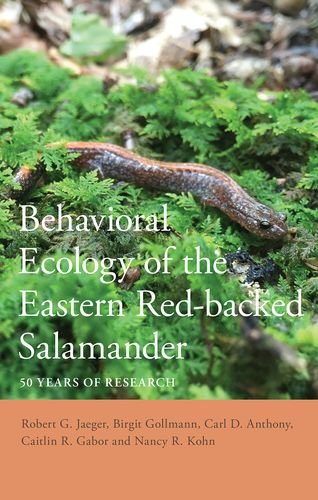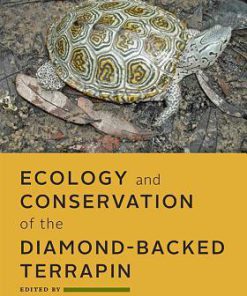Behaviorial ecology of the Eastern red backed salamander 50 years of research 1st Edition by Robert Jaeger, Birgit Gollmann, Carl Anthony, Caitlin Gabor, Nancy Kohn ISBN 9780190628413 0190628413
$50.00 Original price was: $50.00.$25.00Current price is: $25.00.
Behaviorial ecology of the Eastern red backed salamander 50 years of research 1st Edition by Robert Jaeger, Birgit Gollmann, Carl Anthony, Caitlin Gabor, Nancy Kohn – Ebook PDF Instant Download/Delivery: 9780190628413 ,0190628413
Full download Behaviorial ecology of the Eastern red backed salamander 50 years of research 1st Edition after payment
Product details:
ISBN 10: 0190628413
ISBN 13: 9780190628413
Author: Robert Jaeger, Birgit Gollmann, Carl Anthony, Caitlin Gabor, Nancy Kohn
Behaviorial ecology of the Eastern red backed salamander 50 years of research 1st Edition Table of contents:
1. Prelude
1.1. Bob Jaeger meets the eastern red-backed salamander, Plethodon cinereus
1.2. An introduction to red-backed salamanders
1.3. The plot of our research program
1.4. Comments concerning methodology and statistical paradigms
2. Interspecific competition between P. cinereus and P. shenandoah
2.1. Ecological studies
2.2. Behavioral experiments
2.3. Selected recent research by others: Interspecific competition
3. Intraspecific territoriality by P. cinereus
3.1. Definition and theory
3.2. Distribution and prey availability
3.3. Site tenacity by P. cinereus
3.4. Determining sex and defining behavioral patterns
3.5. The use of odors and dear enemy recognition
3.6. The expulsion of intruders
3.7. Testing territoriality in the forest
3.8. Variables that affect territorial contests
3.8.1. Length of residency
3.8.2. Body size
3.8.3. Body size without residency
3.8.4. Sex and reproductive condition
3.8.5. Intruder number
3.8.6. Tail condition
3.8.7. Food quantity
3.8.8. Food quality
3.8.9. Signal honesty
3.9. Life history traits and territorial contests
3.9.1. Variation in reproductive success among females
3.9.2. Payoffs to and RHP of territorial owners
3.9.3. Resource acquisition and energy allocation
3.10. Seasonal and geographic variation in territorial agonistic behavior
3.10.1. Seasonal variation
3.10.2. Geographical variation
3.11. Selected recent research by others: Intraspecific territoriality
4. Foraging tactics by P. cinereus within territories
4.1. Foraging on live versus dead prey
4.2. Diet breadth
4.3. Optimal prey choice
4.4. Territorial and foraging behavioral conflicts
4.5. Assessing prey densities
4.6. Judging prey profitabilities
4.7. Conflicts between foraging behavior and territorial defense
4.8. Diet diversity and clutch size
4.9. Selected recent research by others: Foraging tactics
5. Pheromonal glands and pheromonal communication by P. cinereus
5.1. Early studies suggest pheromones do occur
5.2. Do males of P. cinereus produce territorial pheromones?
5.3. Do females of P. cinereus produce territorial pheromones?
5.4. Where are those pheromones produced in males and females?
5.5. Focusing on the postcloacal gland
5.6. What information does the postcloacal gland communicate?
5.7. What signals do pheromones communicate?
5.8. Scent matching and tail autotomy
5.9. Do territorial pheromones aid in homing behavior by P. cinereus?
5.10. Are pheromones volatile?
5.11. Selected recent research by others: Pheromonal communication
6. Interspecific territoriality and other interspecific behavioral interactions
6.1. Interspecific territoriality between P. cinereus and P. shenandoah
6.2. Rules of engagement with juveniles of P. glutinosus
6.3. Plethodon cinereus in an assemblage of salamanders
6.4. Ecological tests of behavioral predictions: Enclosed plots on the forest floor
6.5. More ecological tests of behavioral predictions: Unenclosed plots on the forest floor
6.6. Character displacement: P. cinereus versus P. hoffmani
6.7. Competition between P. cinereus and P. hubrichti
6.7.1. Habitat niche partitioning?
6.7.2. Microhabitat niche partitioning?
6.7.3. Intra- and interspecific competition?
6.7.4. Intra- and interspecific territoriality?
6.7.5. Summary
6.8. Diversity of behaviors by P. cinereus toward other species
6.9. Selected recent research by others: Interspecific territoriality
7. Intraspecific social behavior within P. cinereus
7.1. Interactions of adults and juveniles in the forest and in the laboratory
7.2. Distributions of adult males and females
7.3. Microdistributions of adults and juveniles
7.4. Female–female interactions
7.5. Male–female behavioral interactions in the forest
7.6. The ESS dating game
7.7. Males, females, and feces
7.8. Females prefer larger males
7.9. Males and females prefer familiar opposite-sex individuals
7.10. Social monogamy
7.11. Mutual mate guarding
7.12. Sexual coercion
7.13. Imperfect information during sexual discrimination?
7.14. Relationship value and conflict resolution
7.15. Natural versus forced partnerships
7.16. Females are often genetically polyandrous
7.17. Switching from social monogamy to social polygamy
7.18. Brooding behavior and neonates: Kin recognition?
7.19. What 3,487 uniquely marked salamanders reveal about social relationships
7.19.1. Basic population ecology
7.19.2. Size distribution and growth rates
7.19.3. Sexual maturity and female fecundity
7.19.4. Population size
7.19.5. Sex ratio
7.19.6. Intersexual associational behavior
7.19.7. Consequences of tail autotomy
7.20. A preliminary model of social organization within P. cinereus
7.21. Selected recent research by others: Social behavior
8. Predator–prey interactions between P. cinereus and a snake
8.1. Can P. cinereus detect the snake visually or chemically?
8.2. Can the snake detect chemical cues from P. cinereus?
8.3. Naïve snakes recognize odors of P. cinereus
8.4. Tail autotomy deceives the snake
8.5. The snake follows the trail of P. cinereus
8.6. The predator–prey evolutionary arms race
8.7. Selected recent research by others: Predator–prey arms races
9. Cognitive ecology of P. cinereus
9.1. Numerical discrimination by P. cinereus
9.2. Both learning and heritability affect foraging ability
9.3. Displacement of territorial aggression
9.4. The impact of familiarity on salamander behavior
9.5. Individual recognition memory
9.5.1. The formation of individual recognition memory
9.5.2. Sensory modalities used during recognition
9.5.3. Do distractors inhibit individual recognition memory?
9.5.4. Overview
9.6. Selected recent research by others: Cognitive ecology
10. Coda: Synthesis and social behaviors by P. cinereus
10.1. Behavioral variation within a population
10.1.1. Age
10.1.2. Tail autotomy
10.1.3. Polymorphism
10.1.4. Health
10.1.5. Bold and shy
10.1.6. Experimental flaws
10.2. Behavioral options during contests
10.3. How salamanders choose among options
10.4. Definitions of social, mating, and genetic monogamy
10.5. Mea maxima culpa
References
Subject Index
People also search for Behaviorial ecology of the Eastern red backed salamander 50 years of research 1st Edition:
behavioral ecology theory
behavioral ecology books
behavioral ecology articles
behavioral ecology is the
Tags:
Robert Jaeger,Birgit Gollmann,Carl Anthony,Caitlin Gabor,Nancy Kohn,Behaviorial ecology,Eastern,red backed,salamander
You may also like…
Uncategorized
Summer of Simulation: 50 Years of Seminal Computer Simulation Research John Sokolowski
Medicine
Perceived Control: Theory, Research, and Practice in the First 50 Years 1st Edition John W. Reich
Politics & Philosophy - Anthropology
Business & Economics
The Economy of Ghana: 50 Years of Economic Development Mozammel Huq
Science (General)
Business & Economics - Real Estate
Biology and other natural sciences
Ecology and Conservation of the Diamond-Backed Terrapin Willem Roosenburg
Politics & Philosophy - Government & Politics












